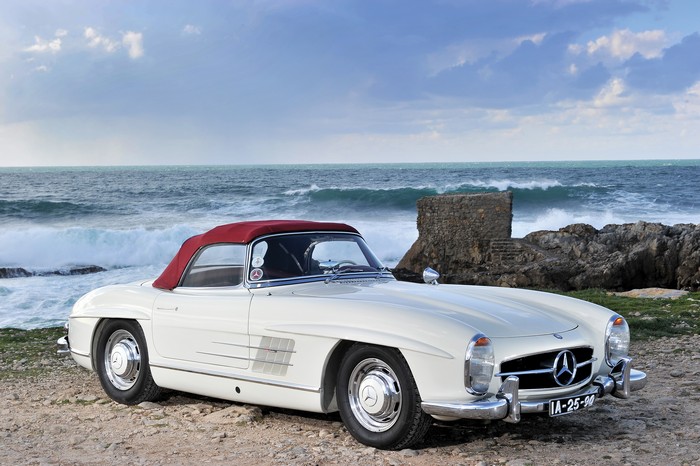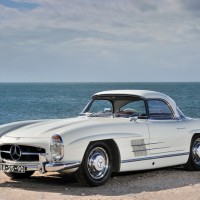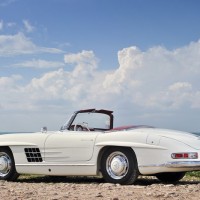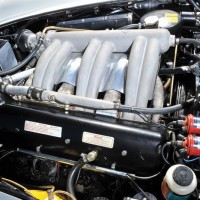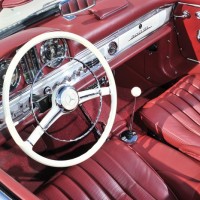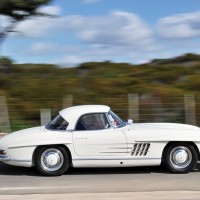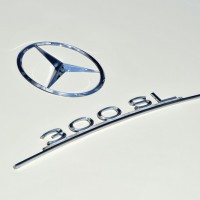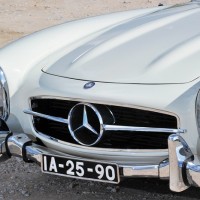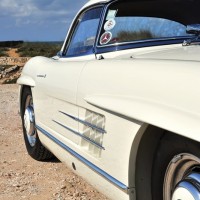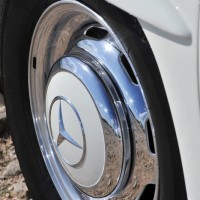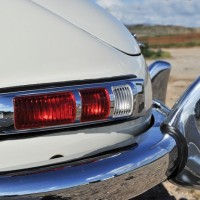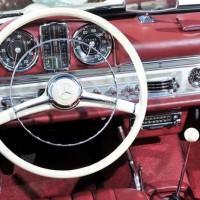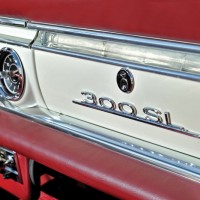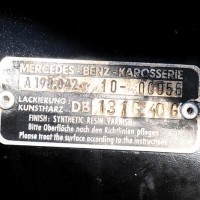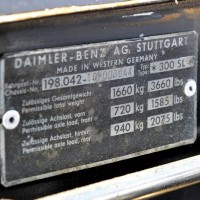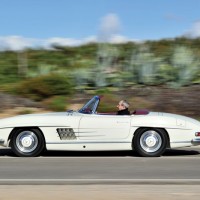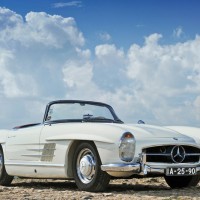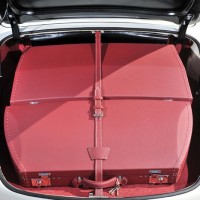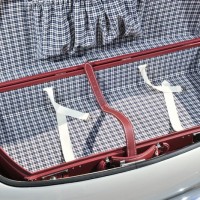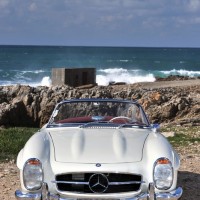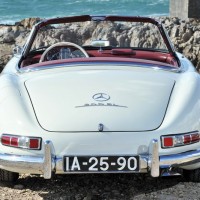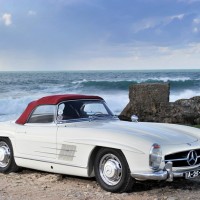Delivered new to Mannheim, Germany, this 300SL Roadster was first sold to a Swiss customer. It has had no more than two registered owners since; it also features a factory hard top. Many aficionados consider the configuration of this example as the most desirable variant, with disc brakes in combination with the more reliable cast-iron block.
This Mercedes has been the subject of a painstaking, five-year, body-off rebuild. Acquired as a rust- and accident-free original car, it was restored to international show quality, using NOS and Mercedes-Benz replacement components. The restoration is documented with an extensive dossier of invoices and photographs.
The car was finished in Mercedes-Benz White (DB-050), with interior in Burgundy, and with matching soft top and a corresponding white hard top. The glass has all been replaced with new pieces from the Mercedes-Benz Classic Center, bearing the correct imprints. The Mercedes also includes a new set of fitted luggage by Karl Baisch. Originally delivered without a radio, it is equipped today with a correct NOS Becker Mexico unit with electric antenna.
During restoration, several upgrades were made to enhance drivability on today’s roads. Originally built with the shortest available gearing, required for mountainous countries, it now features the tallest 3.25:1 ratio for effortless motorway cruising. The cockpit has been heat-insulated for maximum comfort, and the stainless-steel exhaust system and manifold have been thermo-wrapped.
Additionally, the engine has been upgraded for unleaded fuel, with uprated valves and hardened seats. It is equipped with an electronic ignition system. Today, the rebuilt engine, as modified, develops significantly more horsepower than when new.
A major advance is the Easydrive electric power steering. At maximum assist, the car can be parallel-parked with one finger. Other upgrades include an electric radiator fan with both thermostat and manual controls, and a removable blind on the oil cooler, which helps the oil to come up to operating temperature more quickly. An alternator conversion from HK Engineering has been fitted.
Fresh, correct, and highly equipped, this desirable 300SL Roadster is both stunning in appearance and exhilarating in performance.
SCM Analysis
Detailing
| Vehicle: | 1962 Mercedes-Benz 300SL Roadster |
| Number Produced: | 1,858 |
| Original List Price: | $13,000 |
| Tune Up Cost: | $5,000 |
| Chassis Number Location: | Tag on firewall and stamped into front cross member |
| Engine Number Location: | Riveted tag and stamped number on front right side of block below head |
| Club Info: | 300SL Gullwing Group |
| Website: | http://www.lgullwinggroup.com |
This car, Lot 108, sold for $1,448,720, including buyer’s premium, at RM’s Villa Erba sale on May 25, 2013.
First, I have always been a fan of 300SL Roadsters and have owned five of them, including one of the prototype cars. So don’t shoot me for saying I’m confused by 300SL Roadster prices of late — and particularly this sale. Here’s why:
300SLs are magnificent cars. Brilliantly engineered and technologically superior to almost anything else in period, they are one of the few vintage cars that do not feel vintage in use, and they are also remarkably robust in their construction, as one would expect. For a race-bred car, a 300SL is about as docile and comfortable as one could ask for. While I prefer the Gullwing for appearance, there is also no denying the Roadster is a far more user-friendly device, as it is far less prone to try to kill you with snap oversteer or by raising your core temperature on a hot day until you have no choice but to expire.
Levels of desire
In the hierarchy of Roadsters, 1961 and later cars (from chassis 2780) are the most desirable because of factory disc brakes and other improvements.
Trumping that would be a factory disc-brake car with the alloy engine block (from chassis 3049). The catalog description for our subject car (3044) states the cast-iron block was more reliable, and that this was the last example fitted with one. I think both arguments would be hard to prove, let alone add any value. A total of 1,858 300SL Roadsters were produced from 1957 to 1963. For almost any car manufacturer, that is a miniscule production run, but in this two-comma-price world of blue-chip exotics, that’s a big number.
So, the combination of comfort, speed and relatively large production numbers creates an interesting issue for owners who like to participate in vintage rallies — most are over-subscribed with 300SLs, and if you do get in, the answer to the question of “which car are you driving” becomes more complex. Something along the lines of: “The Ivory 300SL.” “With the blue interior.” “And the Minnesota plates.”
Skyrocketing values
From 2008 to 2012, with few exceptions, good 300SL Roadsters were solidly in the $500k–$650k range. Exceptional ones with restorations from known SL specialists such as Paul Russell & Company could bring in the area of $900k.
Anybody who wanted an SL Roadster didn’t have to search too hard, as they are standard fare at any good auction and easy to find with a phone call to the right people. It’s basic supply and demand — and while the demand has always been steady, so has the supply. But the past eight months have brought a dramatic spike in SL prices, and our feature car is the current poster child of that trend.
And here’s what I find really interesting: Our subject car could technically be considered the first $1.4m 300SL resto-mod.
In a world where date-coded hose clamps and counting perforations in the leather to make sure they are all there is the norm, in rolls a subtly modified hot-rod SL that flat rang the bell. It isn’t a spectacular unrestored example; nor is it a Pebble Beach-level, dead-correct restoration. It is a car that somebody with means built to suit their taste and driving desires, which is an undertaking that is typically a detriment to a car’s value.
But not on this day.
Were the modifications what made the difference? While some were sensible, such as the rear-axle ratio and extra heat insulation, I’ve never driven an SL that I thought was hard to steer. I never desired to park with one finger, for that matter.
A proper stock SL offers a sensational driving experience, so I doubt somebody placed a $400k premium on a French electric power-steering kit, a Japanese alternator and a Dutch distributor — all three available as kits for under $3,000 total.
The big question is how much would it cost to bring this car to the current standard for a concours-restored one? That would be the number I would subtract from the market price of a car restored to this level, rather than adding some arbitrary number for the modern upgrades.
As such, there are no two ways about it — this car was well sold. Time will tell if the 300SL market will surpass this result, or fail to sustain these new numbers. Any bets? ?
(Introductory description courtesy of RM Auctions.)
